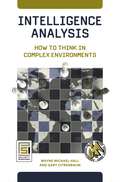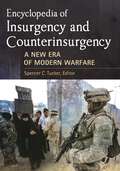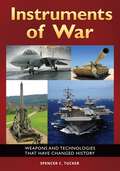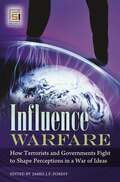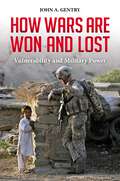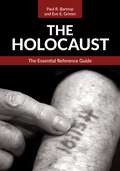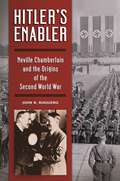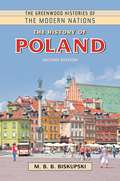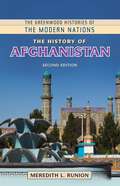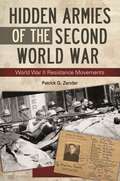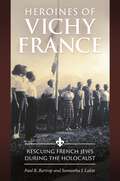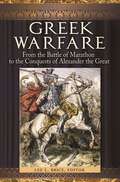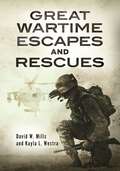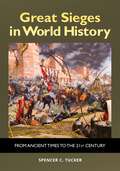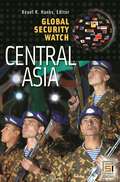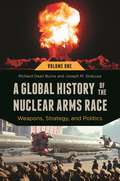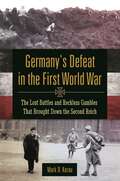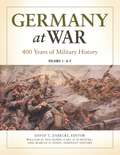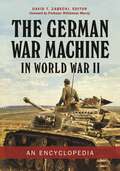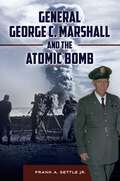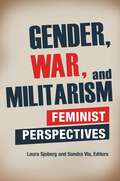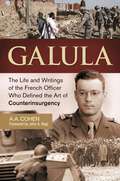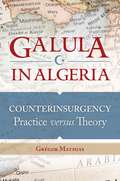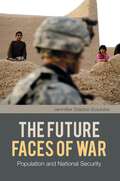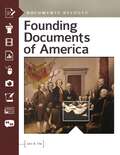- Table View
- List View
Intelligence Analysis: How to Think in Complex Environments (Praeger Security International)
by Wayne Michael Hall Gary CitrenbaumThis book offers a vast conceptual and theoretical exploration of the ways intelligence analysis must change in order to succeed against today's most dangerous combatants and most complex irregular theatres of conflict.Intelligence Analysis: How to Think in Complex Environments fills a void in the existing literature on contemporary warfare by examining the theoretical and conceptual foundations of effective modern intelligence analysis—the type of analysis needed to support military operations in modern, complex operational environments. This volume is an expert guide for rethinking intelligence analysis and understanding the true nature of the operational environment, adversaries, and most importantly, the populace. Intelligence Analysis proposes substantive improvements in the way the U.S. national security system interprets intelligence, drawing on the groundbreaking work of theorists ranging from Carl von Clauswitz and Sun Tzu to M. Mitchell Waldrop, General David Petraeus, Richards Heuer, Jr., Orson Scott Card, and others. The new ideas presented here will help the nation to amass a formidable, cumulative intelligence power, with distinct advantages over any and all adversaries of the future regardless of the level of war or type of operational environment.
Encyclopedia of Insurgency and Counterinsurgency: A New Era of Modern Warfare
by Spencer C. TuckerA fascinating look at the insurgencies and counterinsurgencies throughout history with a concentration on the 20th and 21st centuries.This encyclopedia examines insurgencies—and the counterinsurgency efforts they prompt—through history, addressing military actions and the techniques and technologies employed in each conflict, significant insurgency leaders, and the leading theorists, with emphasis on the "small wars" of the 20th century and most recent decades. The clear, concise entries provide a breadth of coverage that ranges from the Maccabean Revolt in 168–143 BCE and the Peasants' Revolt in Germany in the 1500s to the American Revolutionary War and the ongoing insurgency in Syria. Readers will gain a solid understanding of how insurgency warfare and counterinsurgency (COIN) strategy has played a key role in the U.S. conflicts in Afghanistan and Iraq in the early 21st century, and grasp how this important military strategy has evolved during modern times.
Instruments of War: Weapons and Technologies That Have Changed History
by Spencer C. TuckerThis highly detailed and well-illustrated single-volume work documents the evolution of warfare across history through weaponry and technological change.In war, the weapons and technologies employed have direct effects on how battles are waged. When new weapons are introduced, they can dramatically alter the outcomes of warfare—and consequently change the course of history itself. This reference work provides a fascinating overview of the major weapon systems and military technologies that have had a major impact on world history. Addressing weapons as crude as the club used by primitive man to the high-tech weapons of today such as unmanned drones, Instruments of War: Weapons and Technologies That Have Changed History offers nearly 270 profusely illustrated entries that examine the key roles played by specific weapons and identify their success and failures. The book begins with an introductory essay that frames the subject matter of the work and discusses the history of weapons as a whole. The text is concise and accessible to general readers without extensive backgrounds in military history yet provides the detailed information necessary to convey the complexity of the evolution of warfare through technological change.
Influence Warfare: How Terrorists and Governments Fight to Shape Perceptions in a War of Ideas (Praeger Security International)
by James J. ForestThis important work, edited by an expert on terrorism, focuses on the 21st-century struggle for strategic influence and ways in which states can neutralize the role of new media in spreading terrorist propaganda.In an era where anyone can have access to the Internet or other media forms that make widespread communication easy, terrorists and insurgents can spread their messages with complete freedom, creating challenges for national security. Influence Warfare: How Terrorists and Governments Fight to Shape Perceptions in a War of Ideas focuses on the core of the ongoing struggle for strategic influence and, particularly, how states can counter the role media and the Internet play in radicalizing new agents of terrorism. As the book makes clear, governments need to find ways to effectively confront non-state adversaries at all levels of the information domain and create an understanding of strategic communications within a broad range of technologies. The essays from the international group of authors who contributed to this work offer a deeper understanding of the ongoing struggle. Influence Warfare also provides a set of case studies that illustrate how the means and methods of strategic influence can impact a nation's security.
How Wars Are Won and Lost: Vulnerability and Military Power (Praeger Security International)
by John A. GentryThis provocative book seeks to answer a most crucial—and embarrassing—question concerning the U.S. military: why the United States is so often stymied in military confrontations with seemingly weaker opponents, despite its "superpower" status.This fascinating book examines a question that continues to puzzle soldiers, statesmen, and scholars: why do major powers—including the ostensible superpower United States—repeatedly perform poorly against seemingly overmatched adversaries? And what can they, and the United States, do to better achieve their military objectives?How Wars are Won and Lost: Vulnerability and Military Power argues that beyond relying solely on overwhelming military might, the United States needs to focus more on exploiting weaknesses in their adversaries—such as national will, resource mobilization, and strategic miscues—just as opposing forces have done to gain advantage over our military efforts. The author tests the "vulnerability theory" by revisiting six conflicts from the Philippine War of 1899-1902 to the ongoing actions in Iraq and Afghanistan, showing again and again that victory often depends more on outthinking the enemy than outmuscling them.
The Holocaust: The Essential Reference Guide
by Professor Paul R. Bartrop Eve E. GrimmThis volume provides an indispensable resource for anyone studying the Holocaust. The reference entries are enhanced by documents and other tools that make this volume a vital contribution to Holocaust research.This volume showcases a detailed look at the multifaceted attempts by Germany's Nazi regime, together with its collaborators, to annihilate the Jews of Europe during the Holocaust. Several introductory essays, along with a rich chronology, reference entries, primary documents, images, and a bibliography provide crucial information that readers will need in order to try to understand the Holocaust while undertaking research on that horrible event.This text looks not only at the history of the Holocaust, but also at examples of resistance (through armed violence, attempts at rescue, or the very act of survival itself); literary and cultural expressions that have attempted to deal with the Holocaust; the social and psychological implications of the Holocaust for today; and how historians and others have attempted to do justice to the memory of those killed and seek insight into why the Holocaust happened in the first place.
Hitler's Enabler: Neville Chamberlain and the Origins of the Second World War
by John RuggieroBased largely on Neville Chamberlain's own words and official government documents, this book describes how were it not for Chamberlain's powerful, dominating presence in the British government, World War II might have been avoided.Was Adolf Hitler hell-bent on inciting a war, and there was no course of action by any national leader that could have prevented World War II? Or, did Prime Minister Neville Chamberlain's appeasement policy with Germany and slowness in strengthening England's armed forces directly encourage Hitler to strike, dooming Chamberlain's successor Winston Churchill to face the war that could have been prevented? This book provides an in-depth look at one of the most pivotal moments in England's history, tapping a variety of primary sources to reveal rarely considered perspectives on the story behind the road to World War II. It explains how Chamberlain was driven by a personal agenda to destroy Socialism, which was the primary force behind Chamberlain's "double policy" of gradual rearmament and appeasement of the German dictator that enabled Hitler to strengthen his position in Europe.Author John Ruggiero takes exception to the Revisionist argument that Chamberlain had no choice but to appease Hitler, instead arguing that Charmberlain's pursuit of a policy of appeasement powered Germany's war machine, and as the most important figure in the British government, he therefore bears full responsibility for the failure of that policy. Students of international relations and history will be surprised to learn that Hitler was not wholly responsible for the war, while scholars will be interested in the manner in which Chamberlain managed to control the agenda—and his rationale for doing so.
The History of Poland (The Greenwood Histories of the Modern Nations)
by M. B. BiskupskiThis book is an engaging explanation of the complicated history of Poland, one of the least well-known countries in Europe.Poland, which has one of the strongest economies in the European Union, has faced significant turmoil throughout the years. Encapsulating centuries of development, this book distills Poland's historical evolution into patterns, including those that have developed since the first edition was published nearly 20 years ago. The book begins with an overview of contemporary Poland, providing both basic information about the geography, culture, and current political climate of the country while tying these to major contemporary issues. This introduction is followed by chapters discussing Poland's long history, starting with the 10th century. The second half of the book presents a history of Poland in the 20th and 21st centuries, covering the major issues affecting the country and offering possible interpretations of them. This updated and revised edition accounts for recent events in Poland and examines the effects of the Polish diaspora globally.
The History of Afghanistan (The Greenwood Histories of the Modern Nations)
by Meredith L. RunionThis chronological account traces the history of Afghanistan from pre-civilization to present-day events and considers the future of democracy in Afghanistan.For centuries, Afghanistan has endured control by a gamut of political regimes as a result of its strategic location along the trade route between Asia and the Middle East. The area has been at the center of constant conflict and only in recent years has recovered from the vestiges of warfare. The second edition of this popular reference offers a fresh glimpse at the country, showing modern Afghanistan to be a melting pot of cultures, tribes, and political influences all under the guiding belief of Islam.In addition to thorough coverage of the country's political, economic, and cultural history, the book provides students with an account of recent events in Afghanistan since 2007, such as the death of Osama bin Laden in Pakistan and the removal of NATO soldiers. Other changes include a revised timeline, an updated glossary, additions to the notable figures appendix, and an expanded bibliography that includes electronic resources.
Hidden Armies of the Second World War: World War II Resistance Movements
by Patrick G. ZanderA comprehensive and compelling history of the resistance movements that operated in every German-occupied nation between 1939 and 1941.Even though much of Europe eventually succumbed to the Nazis during World War II, many Europeans defiantly resisted occupation in every way possible. This captivating book provides a survey of these resistance movements during the period of Axis occupation and recounts the ways in which unarmed citizens undermined Nazi efforts at domination. A thorough description of the Axis conquest of Europe, the formation of the Special Operations Executive in Britain, and the Office of Strategic Services in the United States provides a backdrop for this turbulent time in history.Chapters cover the resistance organizations, their leaders, and other key individuals behind their operations. The book details the movement's furtive tactics that included spreading information, providing the Allies with key intelligence, conducting industrial sabotage, destroying bridges and factories, and fighting behind the lines. Case studies of resistance operations in France, Norway, Holland, Denmark, Poland, Czechoslovakia, the Soviet Union, the Balkans, Greece, Italy, and within Nazi Germany itself show the scope and breadth of the resistance movement throughout the world.
Heroines of Vichy France: Rescuing French Jews during the Holocaust
by Paul R. Bartrop Samantha J. LakinThis book tells the largely unknown story behind the rescue activities of several remarkable young Jewish women in Vichy France during World War II and their role in the resistance against Nazi and Vichy France deportation policies.Few studies of Vichy France and the Holocaust have looked at the rescue of Jews by those prepared to risk everything to escort them to safety in the border regions, and even fewer have considered Jewish rescue of Jews, specifically of Jewish children by women. This work will be arguably the first book in which the experiences and efforts of a number of female rescuers—all of whom knew or knew of each other—have been brought together in a single volume, with the object of honoring their memory and showing how the value of human life was sustained through the Holocaust.Focusing on a number of young Jewish women who defied the Nazis, this narrative highlights their courage and sacrifice in their efforts to rescue Jews in France during World War II. Additionally, it shows how these French women responded to Nazi and Vichy France policies of deportation through resistance activities. This is a story that will captivate anyone with an interest in the innate goodness of human beings that can shine even when confronted with the darkest expressions of depravity that occurred during the Holocaust.
Greek Warfare: From the Battle of Marathon to the Conquests of Alexander the Great
by Lee L. BriceThis book brings together reference material and primary source documents concerning the most important people, places, events, and technologies of Classical Greek warfare in one easy-to-use volume—an invaluable resource for students, educators, and general readers interested in this compelling subject. Greek Warfare: From the Battle of Marathon to the Conquests of Alexander the Great is a unique reference book that examines warfare in ancient Greece during the Classical era between 490 and 323 BCE. This easy-to-use, multi-format handbook provides a range of tools for investigating the military history of Classical Greece, including a timeline, reference entries, selected primary source documents, charts, and a glossary. The accessible reference entries illuminate all of the most important topics and issues within Classical Greek warfare, while the book's logical organization allows students, educators, and general readers alike to quickly find the specific information they seek. The comprehensive bibliography serves as a perfect gateway to additional resources on the subject.
Great Wartime Escapes and Rescues
by David W. Mills Kayla L. WestraStudents, military historians, and casual readers will all find this compelling collection useful in learning about escape strategies, hostage situations, and rescue operations during times of conflict.Great Wartime Escapes and Rescues tells the captivating stories of dozens of escapes and rescues from conflicts dating from the 16th century to present, with extensive coverage of the world wars of the 20th century and the Vietnam War. In addition, escapes and rescues related to terrorist activities and regional conflicts are featured. Some stories of escapes and rescues included in this work have been written about extensively and portrayed in films, including The Great Escape and Captain Phillips' rescue by Navy SEALs. Other stories are less widely known but just as absorbing.The book opens with a detailed introductory essay that illuminates the government policies and tactics various countries have used to rescue soldiers and civilians during wartime, as well as the diverse methods that prisoners of war have used to escape notorious camps and prisons. The entries, organized alphabetically, are augmented by engaging sidebars related to the escapes and rescues. The book also includes references to such sources as autobiographies, biographies, news accounts, and interviews with veterans.
Great Sieges in World History: From Ancient Times to the 21st Century
by Spencer C. TuckerThis impressive collection of 100 of the most decisive and important sieges spans human history and covers conflicts in Africa, Asia, Europe, and the Americas.This engaging reference work provides readers with detailed coverage on the sieges that have had the biggest impact on world history. In addition to providing basic factual information, this encyclopedia delves into the historical context and significance of each siege. Readers will be able to identify relationships between entries and observe both the gradual evolution of siege warfare over time, and compare and contrast siege characteristics within and among different historical time periods. The encyclopedia's expansive scope will broaden readers' understanding of military history.The book begins with a preface and an introductory essay that offers a detailed overview of siege warfare throughout history. This is followed by 100 chronological entries on the most significant sieges, beginning with the Siege of Troy (1194–1184 BCE) and ending with the Siege of Mosul (October 17, 2016-July 9, 2017). Each siege entry has a Further Reading section that directs readers to additional information about the siege. Numerous illustrations and maps accompany the text.
Global Security Watch—Central Asia (Global Security Watch)
by Reuel R. HanksThis volume is the only current treatment of security issues in Central Asia for the nonspecialist, as well as specialists and policy-makers.Global Security Watch—Central Asia is the first authoritative examination of the security issues affecting, and affected by, the region where Russia, South Asia, China, and the Middle East meet. The author provides a comprehensive account of the strategic importance and challenges facing Central Asia written for policymakers, students, researchers, and interested general readers alike.Global Security Watch—Central Asia goes behind the scenes to explore both the internal factors and global influences affecting the stability of region and the nations that comprise it. Coverage includes the dynamics of each country's domestic politics, the allure of the region's natural resources, Central Asia's role in U.S./Russian relations, and the renewed focus on the region in the aftermath of the attacks of September 11, 2001.
A Global History of the Nuclear Arms Race [2 volumes]: Weapons, Strategy, and Politics [2 volumes] (Praeger Security International)
by Richard Dean Burns Joseph M. SiracusaWritten by two preeminent authors in the field, this book provides an accessible global narrative of the nuclear arms race since 1945 that focuses on the roles of key scientists, military chiefs, and political leaders.The first book of its kind to provide a global perspective of the arms race, this two-volume work connects episodes worldwide involving nuclear weapons in a comprehensive, narrative fashion. Beginning with a discussion of the scientific research of the 1930s and 1940s and the Hiroshima decision, the authors focus on five basic themes: political dimensions, technological developments, military and diplomatic strategies, and impact.The history of the international nuclear arms race is examined within the context of four historical eras: America's nuclear monopoly, America's nuclear superiority, superpower parity, and the post-Cold War era. Information about the historical development of the independent deterrence of Britain, France, and China, as well as the piecemeal deterrence of newcomers Israel, India, Pakistan, and North Korea is also included, as is coverage of the efforts aimed at the international control of nuclear weapons and the diplomatic architecture that underpins the global nuclear non-proliferation regime.
Germany's Defeat in the First World War: The Lost Battles and Reckless Gambles That Brought Down the Second Reich
by Mark D. KarauA noted World War I scholar examines the critical decisions and events that led to Germany's defeat, arguing that the German loss was caused by collapse at home as well as on the front.Much has been written about the causes for the outbreak of World War I and the ways in which the war was fought, but few historians have tackled the reasons why the Germans, who appeared on the surface to be winning for most of the war, ultimately lost. This book, in contrast, presents an in-depth examination of the complex interplay of factors—social, cultural, military, economic, and diplomatic—that led to Germany's defeat.The highly readable work begins with an examination of the strengths and weaknesses of the two coalitions and points out how the balance of forces was clearly on the side of the Entente in a long and drawn-out war. The work then probes the German plan to win the war quickly and the resulting campaigns of August and September 1914 that culminated in the devastating defeat in the First Battle of the Marne. Subsequent chapters discuss the critical factors and decisions that led to Germany's loss, including the British naval blockade, the role of economic factors in maintaining a consensus for war, and the social impact of material deprivation.
Germany at War [4 volumes]: 400 Years of Military History [4 volumes]
by David T. Zabecki William H. Van Husen Carl O. Schuster Marcus O. JonesWritten by experts for use by nonexperts, this monumental work probes Germany's "Genius for War" and the unmistakable pattern of tactical and operational innovation and excellence evident throughout the nation's military history.Despite having the best military forces in the world, some of the most advanced weapons available, and unparalleled tactical proficiency, Germany still lost both World Wars. This landmark, four-volume encyclopedia explores how and why that happened, at the same time examining Germany as a military power from the start of the Thirty Years' War in 1618 to the present day. Coverage includes the Federal Republic of Germany, its predecessor states, and the kingdoms and principalities that combined to form Imperial Germany in 1871.The Seven Years' War is discussed, as are the Napoleonic Wars, the Wars of German Unification (including the Franco-Prussian War), World War I, World War II, and the Cold War. In all, more than 1,000 entries illuminate battles, organizations, leaders, armies, weapons, and other aspects of war and military life. The most comprehensive overview of German military history ever to appear in English, this work will enable students and others interested in military history to better understand the sociopolitical history of Germany, the complex role conflict has played in the nation throughout its history, and why Germany continues to be an important player on the European continent.
The German War Machine in World War II: An Encyclopedia
by David T. ZabeckiThis invaluable resource offers students a comprehensive overview of the German war machine that overran much of Europe during World War II, with close to 300 entries on a variety of topics and a number of key primary source documents.This book provides everything the reader needs to know about the German war machine that developed into the potent armed force under Adolf Hitler. This expansive encyclopedia covers the period of the German Third Reich, from January 1933 to the end of World War II in Europe, in May 1945. Dozens of entries on key battles and military campaigns, military and political leaders, military and intelligence organizations, and social and political topics that shaped German military conduct during World War II are followed by an illuminating epilogue that outlines why Germany lost World War II.A documents section includes more than a dozen fascinating primary sources on such significant events as the Tripartite Pact among Germany, Italy, and Japan; the Battle of Stalingrad; the Normandy Invasion; the Ardennes Offensive; and Germany's surrender. In addition, six appendices provide detailed information on a variety of topics such as German aces, military commanders, and military medals and decorations. The book ends with a chronology and a bibliography of print resources.
General George C. Marshall and the Atomic Bomb
by Frank A. Jr.This book details the evolution of General George Marshall's relationship with the atomic bomb—including the Manhattan Project and the use of atomic weapons on Japan—as it emerged as the ultimate weapon of mass destruction.The atomic bomb is not only the most powerful weapon ever used in the history of warfare: it is also the most significant in terms of its long-term impact on U.S. military power and policy, and as the reason behind the conflict that raged for four decades without actually happening—the Cold War. General George C. Marshall played an instrumental role in the development and use of the atomic bomb in World War II as well as in issues involving nuclear weapons in the post-World War II period. This book tells the story of Marshall's experience with the atomic bomb from his early skepticism of its effectiveness as a weapon, to his oversight of its development and deployment against Japan in World War II, to his recognition of the bomb as a weapon of such dire consequence that it should never be used again.Intended for a general audience as well as scholars with specific knowledge about the subject matter, this book presents a cohesive account of General Marshall's involvement with nuclear weapons and atomic power as Army chief of staff during World War II and as secretary of state and secretary of defense in the early years of the Cold War. Marshall's involvement with the use of nuclear weapons is set in the context of the Allies' efforts to force Japan to surrender and the initiation of the Cold War. Readers will gain insight into Marshall's quest for obtaining a Japanese surrender; his views on the use of the atomic bomb on Japan versus the use of conventional weapons, including fire bombing or poison gas; his interactions with Roosevelt and Truman on nuclear issues; and Marshall's diplomatic skillfulness in dealing with the issues surrounding the control and use of nuclear weapons as secretary of state and secretary of defense in the post-World War II era. These included consideration of the use of the atomic bomb during the Berlin crisis and the Korean war.
Gender, War, and Militarism: Feminist Perspectives (Praeger Security International)
by Laura Sjoberg Sandra ViaThis compelling, interdisciplinary compilation of essays documents the extensive, intersubjective relationships between gender, war, and militarism in 21st-century global politics.Feminist scholars have long contended that war and militarism are fundamentally gendered. Gender, War, and Militarism: Feminist Perspectives provides empirical evidence, theoretical innovation, and interdisciplinary conversation on the topic, while explicitly—and uniquely—considering the links between gender, war, and militarism. Essentially an interdisciplinary conversation between scholars studying gender in political science, anthropology, and sociology, the essays here all turn their attention to the same questions. How are war and militarism gendered?Seventeen innovative explanations of different intersections of the gendering of global politics and global conflict examine the theoretical relationship between gender, militarization, and security; the deployment of gender and sexuality in times of conflict; sexual violence in war and conflict; post-conflict reconstruction; and gender and militarism in media and literary accounts of war. Together, these essays make a coherent argument that reveals that, although it takes different forms, gendering is a constant feature of 21st-century militarism.
Galula: The Life and Writings of the French Officer Who Defined the Art of Counterinsurgency
by A A. CohenThis comprehensive analytical biography is the definitive work on the life and writings of history's most significant counterinsurgency doctrinaire, David Galula, elucidating the context for his reflections and examining the present and future applicability of his treatise for scholars and practitioners alike.The product of years of extensive research made possible by exclusive access to Galula's personal papers as well as first-hand accounts from colleagues, family members, and friends, this book traces Galula's life from early childhood until death, describing his upbringing, education, and military career in the tumultuous historical context of his era. The author—a former counterinsurgency practitioner himself—pays particular attention to how the Chinese Revolution and the Algerian War affected Galula's views, and identifies Galula's mentors and the schools of thought within the French military that greatly influenced his writings. A conclusion illuminates the contemporary and likely future validity of his works. In the epilogue, the author speaks to Galula's influence over modern military thought and U.S. counterinsurgency doctrine. This book is essential reading for individuals with an interest in counterinsurgency, Galula's writings, or Galula himself, such as military officers and civilian administrators undertaking counterinsurgency courses and training.
Galula in Algeria: Counterinsurgency Practice versus Theory (Praeger Security International)
by Grégor MathiasThis groundbreaking investigation uncovers serious mismatches between David Galula's counterinsurgency practice in Algeria and his counterinsurgency theory—the foundation of current U.S. counterinsurgency doctrine in Iraq and Afghanistan.Given the centrality of David Galula's theory to U.S. Counterinsurgency (COIN) doctrine in Iraq and Afghanistan, it is striking that there has been no independent evaluation of Galula's recollection of his COIN operations in Algeria. Galula in Algeria: Counterinsurgency Practice versus Theory delivers just such an analysis, exploring the colonial French counter-insurrectionary theoretical milieu of which Galula's COIN theory was a part, the influence of Galula's theory on U.S. COIN doctrine, and the current views of Galula's theory in France and other NATO countries. French defense researcher Grégor Mathias compares each of the eight steps of Galula's theory set out in Counterinsurgency Warfare against his practice of them as described in his writings and now, for the first time, against the SAS archives and those of Galula's infantry company and battalion. The study shows that Galula systematically inflated his operational successes to match his theoretical scheme and that he left problems unresolved, causing his work to unravel quickly after he left his command. Mathias concludes that, however heuristically fruitful Galula's theory might prove for U.S. COIN doctrine, it must be interpreted and implemented under the caveat that it was not successfully field-tested by its author..
The Future Faces of War: Population and National Security (The Changing Face of War)
by Jennifer Dabbs SciubbaThis comprehensive and clear volume reveals the numerous ways demographic trends such as age structure, composition, and migration influence national security.Population size, structure, distribution, and composition affect security in numerous ways, including national power, civil conflict, and development. The Future Faces of War: Population and National Security offers a comprehensive overview of how demographic trends can function as components, indicators, and multipliers of a state's national security. Each chapter focuses on a particular demographic trend and describes its national security implications in three realms—military, regime, and structural.Illustrating the mechanisms by which demography and security are connected, the book pushes the conversation forward by challenging common conceptions about demographic trends and national security. Key for policymakers and general readers alike, it goes on to suggest ways trends can provide opportunities for building partnerships and strengthening states. Focusing on multiple scenarios and the theoretical links between population and security, the insights gathered here will remain relevant for years to come.
Founding Documents of America: Documents Decoded (Documents Decoded)
by John R. VileWritten by a renowned expert on the American Founding period, this book examines selections of key documents from 1215 through 1791 that were instrumental to the development of the U.S. Constitution and the American political tradition.The latest addition to ABC-CLIO's popular Documents Decoded series, John R. Vile's Founding Documents of America presents historic documents key to the foundations of our nation's government accompanied by introductions that supply background information and analysis that highlights key provisions and provide historical context. The coverage extends beyond the Declaration of Independence, the Constitution, and the Bill of Rights to provide contextual understanding of a wide range of other documents, such as private diary entries and political polemics, that will further readers' understanding of the United States' founding and early political development.The documents are organized chronologically into four sections: constitutional antecedents; the revolutionary and confederal periods; calling and convening the Constitutional Convention; and debating, ratifying, implementing, and amending the new Constitution. Through its more than 50 primary source documents—from the Magna Carta of 1215 through the Bill of Rights, which was adopted in 1791—this book will serve high school and college students seeking to understand the documents that laid the foundations for the U.S. Constitution and Bill of Rights, and provide opportunities for student readers to build critical thinking skills.
